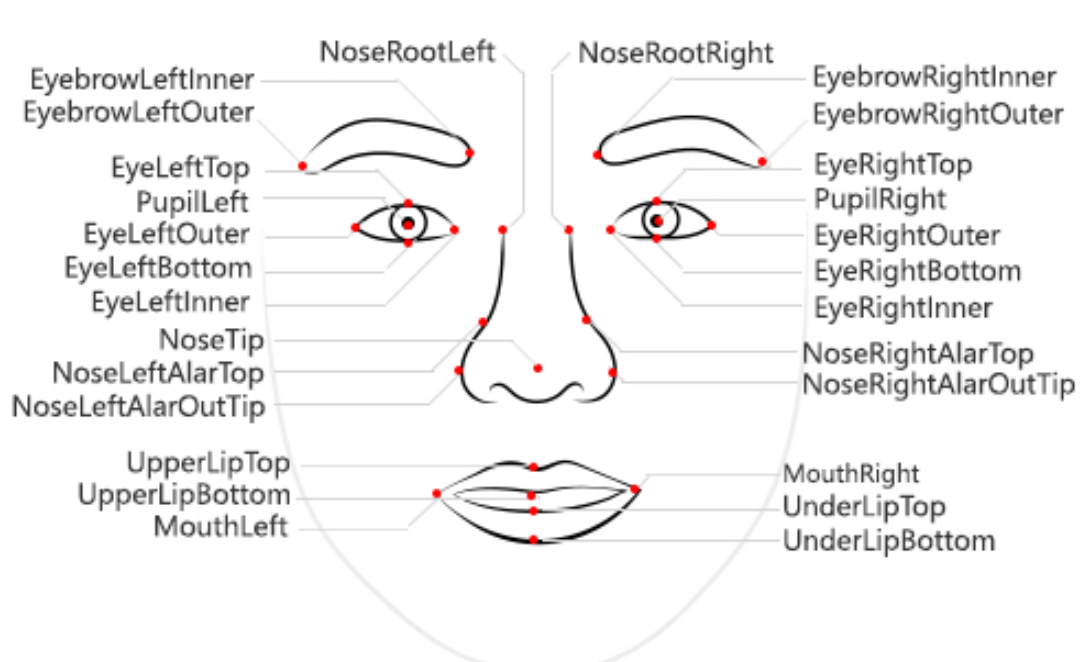2 Computer Vision: 2 Fundamentals of Facial Recognition
1/8
There's no tags or description
Looks like no tags are added yet.
Name | Mastery | Learn | Test | Matching | Spaced |
|---|
No study sessions yet.
9 Terms
[intro to facial recognition]
Face detection and analysis is an area of artificial intelligence (AI) which uses algorithms to locate and analyze human faces in images or video content.
There are many applications for face detection, analysis, and recognition.
Security - facial recognition can be used in building security applications, and increasingly it is used in smart phones operating systems for unlocking devices.
Social media - facial recognition can be used to automatically tag known friends in photographs.
Intelligent monitoring - for example, an automobile might include a system that monitors the driver's face to determine if the driver is looking at the road, looking at a mobile device, or shows signs of tiredness.
Advertising - analyzing faces in an image can help direct advertisements to an appropriate demographic audience.
Missing persons - using public cameras systems, facial recognition can be used to identify if a missing person is in the image frame.
Identity validation - useful at ports of entry kiosks where a person holds a special entry permit.
To use the Face service, you must create one of the following types of resource in your Azure subscription:
Face
Azure AI services
![<p>[Understand Facial Analysis]</p>](https://knowt-user-attachments.s3.amazonaws.com/40d1473f-871f-46a9-8650-f75896387849.png)
[Understand Facial Analysis]
Face detection involves identifying regions of an image that contain a human face, typically by returning bounding box coordinates that form a rectangle around the face
With Face analysis, facial features can be used to train machine learning models to return other information, such as facial features such as nose, eyes, eyebrows, lips, and others

facial recognition
[Understand Facial Analysis]
A further application of facial analysis is to train a machine learning model to identify known individuals from their facial features.
This is known as [], and uses multiple images of an individual to train the model so that it can detect those individuals in new images on which it wasn't trained.
When used responsibly, [] is an important and useful technology that can improve efficiency, security, and customer experiences.
![<ul><li><p>A further application of facial analysis is to <strong>train a machine learning model to identify known individuals from their facial features</strong>. </p><ul><li><p>This is known as [], and <strong>uses multiple images of an individual to train the model</strong> so that it can detect those individuals in new images on which it wasn't trained.</p></li></ul></li><li><p><span>When used responsibly, [] is an important and useful technology that <strong>can improve efficiency, security, and customer experiences</strong>. </span></p></li></ul><p></p>](https://knowt-user-attachments.s3.amazonaws.com/3184751c-e613-4563-97ba-41a426c94438.png)
[Get started with facial analysis on Azure]
Microsoft Azure provides multiple Azure AI services that you can use to detect and analyze faces, including:
Azure AI Vision, which offers face detection and some basic face analysis, such as returning the bounding box coordinates around an image.
Azure AI Video Indexer, which you can use to detect and identify faces in a video.
Azure AI Face, which offers pre-built algorithms that can detect, recognize, and analyze faces
Azure AI Face Service
[Get started with facial analysis on Azure]
The Azure AI Face service can return the rectangle coordinates for any human faces that are found in an image, as well as a series of related attributes:
Accessories: indicates whether the given face has accessories. This attribute returns possible accessories including headwear, glasses, and mask, with confidence score between zero and one for each accessory.
Blur: how blurred the face is, which can be an indication of how likely the face is to be the main focus of the image.
Exposure: such as whether the image is underexposed or over exposed. This applies to the face in the image and not the overall image exposure.
Glasses: whether or not the person is wearing glasses.
Head pose: the face's orientation in a 3D space.
Mask: indicates whether the face is wearing a mask.
Noise: refers to visual noise in the image. If you have taken a photo with a high ISO setting for darker settings, you would notice this noise in the image. The image looks grainy or full of tiny dots that make the image less clear.
Occlusion: determines if there might be objects blocking the face in the image.
Quality For Recognition: a rating of high, medium, or low that reflects if the image is of sufficient quality to attempt face recognition on.
responsible use of AI
[Get started with facial analysis on Azure]
Anyone can use the Face service to:
Detect the location of faces in an image.
Determine if a person is wearing glasses.
Determine if there's occlusion, blur, noise, or over/under exposure for any of the faces.
Return the head pose coordinates for each face in an image.
The Limited Access policy requires customers to submit an intake form to access additional Azure AI Face service capabilities including:
Face verification: the ability to compare faces for similarity.
Face identification: the ability to identify named individuals in an image.
Liveness detection: the ability to detect and mitigate instances of recurring content and/or behaviors that indicate a violation of policies (eg. such as if the input video stream is real or fake).
Tips for more accurate results
[Get started with facial analysis on Azure]
There are some considerations that can help improve the accuracy of the detection in the images:
Image format - supported images are JPEG, PNG, GIF, and BMP.
File size - 6 MB or smaller.
Face size range - from 36 x 36 pixels up to 4096 x 4096 pixels. Smaller or larger faces will not be detected.
Other issues - face detection can be impaired by extreme face angles, extreme lighting, and occlusion (objects blocking the face such as a hand).
Exercise
4